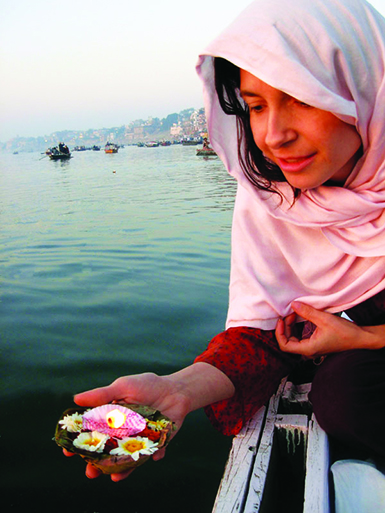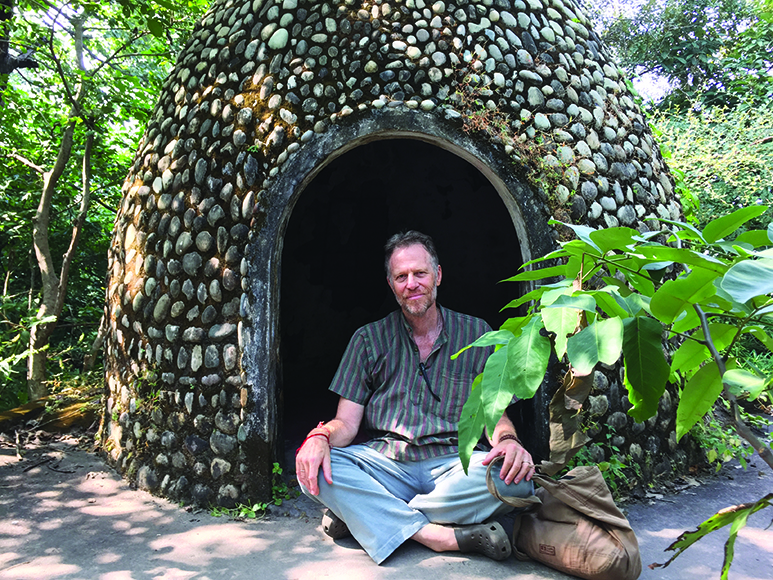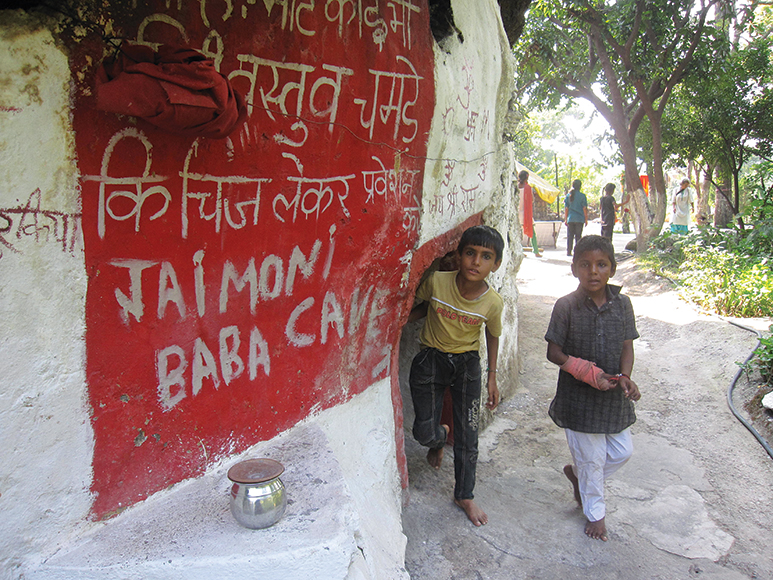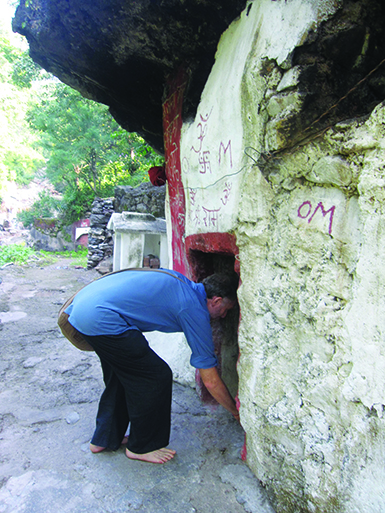Once upon a time in a long-ago decade, before doctors were recommending meditation to control blood pressure and insomnia, before football teams and tech companies were using it to get better at crushing the competition, I started my career as a meditation teacher. Back then, mainstream folks were generally curious but dubious: Was this some kind of weirdo-hippie-Eastern-mystic-cult thing? So, in every public talk, I included a spiel along the lines of, “You don’t have to wear beads. You don’t have to wear orange robes. You don’t have to shave your head. You don’t have to change your name to Rainbow Blissananda. And you don’t have to go sit in a cave in India.”
I still stand by those statements.
But …
I knew there were stories of yogis and hermits who dwelt in caves for years, and I suspected there was something to it, something deeper and more real than my flip caricature of them. Eventually, I got around to sitting in a couple of caves in India myself — briefly, but long enough to confirm that my suspicion was correct.
First Encounters
My first encounter was on Arunachala, the red hill of Lord Shiva above the pilgrimage town of Tiruvanamalai, where sadhus (holy men) have lived in caves for centuries. The most famous was Sri Ramana Maharshi, the great 20th-century sage whose starkly simple method of “Who am I?” inquiry has sparked awakening for countless people. About halfway up Arunachala is the tiny cave where, after his own sudden awakening at age sixteen, Ramana sat for seven years.
The tradition is to climb there barefoot, which my wife and I did — but with our shoes stuffed discreetly into our backpacks. You’re supposed to check them at the ashram at the bottom of the hill, but the wallah in charge of guarding shoes didn’t inspire much confidence; he was fast asleep. Hiking up the red clay trail, with its spectacular view of the sprawling Shiva temple far below, was inspiring. But when we got to the cave itself, we found that it felt rather uncavelike. A little wooden anteroom had been built against its entrance, lined with a couple of commemorative plaques and several framed photos of Ramana at various ages. And the cave was so small and shallow, and such a popular pilgrimage site, that we had to squeeze in with two other Westerners for a couple of minutes of token meditation, then scoot right out to make room for the next two.
As a cave experience, at least for these two pilgrims on that particular day, it was pretty undramatic. But as we started back down, I realized how ironically appropriate that was. Sri Ramana taught not to seek intense experiences, whether mundane or spiritual, but rather to abide in the experiencer — to keep turning the attention inward to the changeless Self that is nonjudgmentally aware of all experiences. Nothing flashy happening? Perfect.

Singer – teacher Gina Salá led the author’s trip to India.
Above Rishikesh
Our next cave experience took place above Rishikesh, in the foothills of the Himalayas. Although we usually travel on our own, this time we went with a group led by Gina Salá, an extraordinary kirtan singer/teacher and spiritual explorer who’s deeply connected to India’s sacred places and awakened teachers. One morning our little group squeezed into a minibus and headed north along the western bank of the Ganga (Ganges). After winding our way fourteen kilometers uphill and upstream, we arrived at the cave of the ancient sage Vasishtha. That section of the Ganga is lined by a broad, rocky beach. Above it, where the hills and forests begin, a small temple stands near the cave, the birthplace of the Gayatri Mantra. As we sat in the courtyard between the temple and the cave, with Gina playing the harmonium and leading us in 108 repetitions of the mantra, it seemed to take on a special spiritual electricity. She also recounted the long story of the mighty King Vishwamitra and his envy of Vasishtha’s enlightenment. (Like most arrogant kings in legends and scriptures, Vishwamitra can be taken as a metaphor for the sense of an isolated, separate self — the “ego” — which is always trying to control the world, while Vasishtha symbolizes realization, which pierces the egoic illusions of control and isolation.) The story ends at Vasishtha’s cave, where, after many years of striving to best him, Vishwamitra finally collapses in surrender at the sage’s feet. He immediately goes into a deep samadhi state, and from within that boundless silence cognizes the Gayatri Mantra, calling upon the Infinite to illuminate the minds of all beings with the light of realization. Today, the Gayatri is chanted every morning, afternoon, and evening all up and down the Ganga and by millions of people throughout the world.

The author at the ruins of the Maharishi Mahesh Yogi Ashram in Rishikesh.
Despite the cave’s renown, there was no line of tourists waiting their turn to get in, just one or two Indian families in no hurry to be anywhere else. It’s also roomier than Ramana’s cave, so we could sit there, meditate, and commune with its spirit at our leisure. There we felt what might be described as a warm glow of timelessness. We felt profoundly connected to a living tradition that has passed along the spark of enlightenment for millennia, and those millennia seemed at once both ancient and completely present. Of course, Gina’s heartfelt recitation of the story helped — she tells those tales with the wide-eyed passion of an eyewitness.
Baba’s Cave
We sat in our third cave just a few days later. It was the most sensational experience yet, and it happened by mistake. For decades, I had heard stories about the great 20th-century cave-dwelling sadhu Tat Wale Baba. He was a striking figure: extraordinarily strong and beautiful, clad only in a loincloth in all seasons, with the powerful, noble look of an American Plains Indian warrior. His long dreadlocks trailed on the ground, yet his face and body were completely hairless — a side effect, according to the spiritual rumor mill, of having attained full enlightenment before puberty.
There were other rumors as well, including claims that he was over 100 years old, despite looking perpetually 35; that he climbed easily over the rocks and hills although his eyes were covered by cataracts (“These eyes? Oh, I don’t use these eyes,” he is supposed to have said); that he talked things over with the local cobras and convinced them not to attack people; and that he predicted he would be murdered — shot in the back — by a crazed, jealous sadhu. That, in fact, is exactly what happened in 1974, and if even a fraction of the other legends are true, Tat Wale Baba was a man of rare spiritual power. I was eager to visit the cave where he had spent long hours in meditation every day. Unfortunately (and surprisingly), no one in the town seemed to have heard of him. Even the local travel bureau, which pointed visitors to pilgrimage sites every day, had no information.
We were nearing the end of our stay, so one day I, my wife, Gina, and two other friends set out across the narrow, crowded Ram Jhula footbridge to the eastern bank, turned right, and walked along the river to the southern outskirts of town. Knowing only that the cave was supposed to be somewhere in the vicinity of the ruins of Maharishi Mahesh Yogi’s ashram (famously visited by the Beatles in 1968), we kept asking directions of locals who just shook their heads, till we found ourselves, without a clue, hiking up into the hills above town on a dusty, unpaved, unmarked, unfrequented forest road. Eventually — and amazingly — a white gypsy cab materialized, and we flagged it down. The young driver spoke only enough English to say, “Baba cave? I take you Baba cave,” and to haggle over the fare. We piled in.

Local kids at Moni Baba Cave
After slamming a few miles along the rutted roads at some truly alarming speeds and watching the monkeys dash for safety, we were suddenly headed straight up the hillside on a “road” that was nothing but rocks. Finally, we disembarked at a clearing where, under a makeshift lean-to, four or five local women and children were partaking of a bandhara: the customary free meal offered at monastic camps on special days. There were also two 30-ish, limited-English-speaking sadhus. Their laundry (orange robes, as a matter of fact) was hanging on a line to dry, and behind them was their tumble-down plank-and-rock hermitage. Beyond that was a rocky hill fronting a small waterfall, and, on one side of it, a tiny, dark entrance. At last, the mouth of the baba’s cave.
But at the hermitage we saw a few pictures of the baba and a sign telling his story … and it was the wrong baba! This was Mouni Baba — one of many mouni or moni or mauni (silent) babas throughout India. He was an impressive-looking holy man with a pale, round, radiant face and robes, but clearly not the dark, nearly naked Tat Wale Baba. A hand-printed sign told his story, how he had sat in the cave in silence for decades, then one day wandered north into the Himalayas to take his final samadhi.

Entering Moni Baba Cave
Wrong baba. But here we were. Beside the entrance, “MONI BABA” and a couple of auspicious swastikas had been painted in red. By bending low, I could just squeeze through the entrance. Immediately I was in total, enveloping darkness, and the sounds of the waterfall and the Indian kids at play faded away. A few yards in, the ceiling slanted still lower, till I was crawling on hands and knees through a tunnel barely high enough and wide enough for one person to pass through at a time. My four companions were somewhere behind me, but in the dark I felt completely alone and vulnerable. Fearful fantasies clamored for my attention: Was this a trap where gullible Westerners, gathered up by conniving taxi drivers, were lured to be knocked on the head and robbed?
After a few more yards, even in the pitch black, I could sense the tunnel opening out into a bigger space. Just then, one of the young sadhus somehow slipped past me, bearing a lantern, and set it in the middle of this space. The others caught up to us, we sat, and we gestured for him to put out the light.
Whooooosh.
Deep, deep silence. Deep, deep darkness. Silent darkness so deep and so powerful that it wasn’t an absence, but a vibrant, scintillating presence. The world was gone, time was gone, space was gone, and in the darkness even my body was gone. Only awareness. Only a few vestigial thoughts remained, but with the outside world gone, they had nothing to pertain to and swiftly died. Only the Self.
Oh, yes.
This was why, for centuries, people sat in caves. This was the silence you couldn’t hide from, you couldn’t distract yourself from, you couldn’t wrap in tidy concepts or stories like a package with a pink bow. You could only surrender to it — only dissolve.
I’m back home in Santa Monica now, where it’s sunny and 72. A Harley has just roared past my house, setting a couple of neighborhood dogs off into a barking contest. I peck away at my keyboard, spinning out these sentences. Occasionally I check my email, where I’m juggling workshop dates and plane reservations, or distract myself with The New York Times online — summoning, at the touch of a key, a world’s worth of melodrama and chaos.
But beneath it all, in a way that hasn’t always been there — or, at least, that I haven’t always recognized — is a certain space of silence. It’s not one I have to travel to India for or crawl on hands and knees to get inside. It’s inside of me. Beneath all the sensations and thoughts, it is me, the one that silently witnesses the thoughts, the body, the world. My teachers and my experience have shown me that I can settle into it anywhere, including the L.A. freeway system and the New York subway system. Nothing needs to be blocked out. Sitting in a cave is optional.
But it’s good.
Dean Sluyter (DeanWords.com) teaches meditation in Santa Monica and leads workshops throughout the United States and beyond. His latest book is Fear Less: Living Beyond Fear, Anxiety, Anger, and Addiction.
